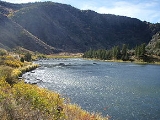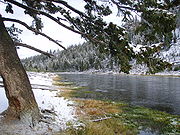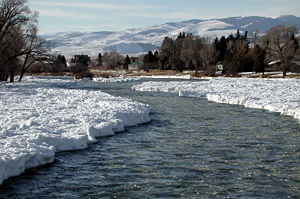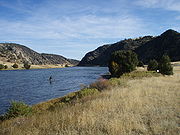
Madison River
Encyclopedia
The Madison River is a headwater tributary
of the Missouri River
, approximately 183 miles (295 km) long, in Wyoming
and Montana
. Its confluence
with the Jefferson
and Gallatin
rivers near Three Forks, Montana
form the Missouri River.
The Madison rises in Park County in northwestern Wyoming at the confluence of the Firehole
and Gibbon
rivers, a location known as Madison Junction in Yellowstone National Park
. It flows west then north through the mountains of southwestern Montana to join the Jefferson and Gallatin rivers at Three Forks. The Missouri River Headwaters State Park is located on the Madison at Three Forks. In its upper reaches in Gallatin County, Montana
, the Hebgen Dam
forms Hebgen Lake
. In its middle reaches in Madison County, Montana
, the Madison Dam forms Ennis Lake and provides hydroelectric power. In 1959, the Hebgen Lake earthquake
formed Quake Lake
just downstream from Hebgen Dam. Downstream from Ennis, the Madison flows through Bear Trap Canyon, known for its class IV-V whitewater
. The Bear Trap Canyon section is part of the Lee Metcalf Wilderness
area.
The river was named in July 1805 by Meriwether Lewis
at Three Forks. The central fork of the three, it was named for U.S. Secretary of State
James Madison
, who would succeed Thomas Jefferson
as President
in 1809. The western fork, the largest, was named for President Jefferson and the east fork for Treasury Secretary
Albert Gallatin
.
The Madison is a Class I river in Montana for the purposes of access for recreational use.
mecca for serious anglers. It is classified as a blue ribbon fishery
in Montana and is one of the most productive streams in Montana for brown trout
, rainbow trout
and mountain whitefish
.
For angling purposes, the Madison can be divided into four distinct sections.
Tributary
A tributary or affluent is a stream or river that flows into a main stem river or a lake. A tributary does not flow directly into a sea or ocean...
of the Missouri River
Missouri River
The Missouri River flows through the central United States, and is a tributary of the Mississippi River. It is the longest river in North America and drains the third largest area, though only the thirteenth largest by discharge. The Missouri's watershed encompasses most of the American Great...
, approximately 183 miles (295 km) long, in Wyoming
Wyoming
Wyoming is a state in the mountain region of the Western United States. The western two thirds of the state is covered mostly with the mountain ranges and rangelands in the foothills of the Eastern Rocky Mountains, while the eastern third of the state is high elevation prairie known as the High...
and Montana
Montana
Montana is a state in the Western United States. The western third of Montana contains numerous mountain ranges. Smaller, "island ranges" are found in the central third of the state, for a total of 77 named ranges of the Rocky Mountains. This geographical fact is reflected in the state's name,...
. Its confluence
Confluence
Confluence, in geography, describes the meeting of two or more bodies of water.Confluence may also refer to:* Confluence , a property of term rewriting systems...
with the Jefferson
Jefferson River
The Jefferson River is a tributary of the Missouri River, approximately long, in the U.S. state of Montana. The Jefferson River and the Madison River form the official beginning of the Missouri at Missouri Headwaters State Park near Three Forks...
and Gallatin
Gallatin River
The Gallatin River is a tributary of the Missouri River, approximately 120 mi , in the U.S. states of Wyoming and Montana...
rivers near Three Forks, Montana
Three Forks, Montana
Three Forks is a city in Gallatin County, Montana, United States and is located within the watershed valley system of both the Missouri and Mississippi rivers drainage basins — and is historically considered the birthplace or start of the Missouri River. The population was 1,728 at the 2000 census...
form the Missouri River.
The Madison rises in Park County in northwestern Wyoming at the confluence of the Firehole
Firehole River
The Firehole River is one of two major tributaries of the Madison River. It flows north approximately from its source in Madison Lake on the Continental Divide to join the Gibbon River at Madison Junction in Yellowstone National Park...
and Gibbon
Gibbon River
The Gibbon River is a river in Yellowstone National Park, in Wyoming, the United States. It rises in the center of the park at Grebe Lake. It flows for a short distance into Wolf Lake. Below Wolf Lake, the river flows through Virginia Cascades into the Norris valley. It flows near the Norris...
rivers, a location known as Madison Junction in Yellowstone National Park
Yellowstone National Park
Yellowstone National Park, established by the U.S. Congress and signed into law by President Ulysses S. Grant on March 1, 1872, is a national park located primarily in the U.S. state of Wyoming, although it also extends into Montana and Idaho...
. It flows west then north through the mountains of southwestern Montana to join the Jefferson and Gallatin rivers at Three Forks. The Missouri River Headwaters State Park is located on the Madison at Three Forks. In its upper reaches in Gallatin County, Montana
Gallatin County, Montana
-National protected areas:* Gallatin National Forest * Yellowstone National Park -Demographics:As of the census of 2000, there were 67,831 people, 26,323 households, and 16,188 families residing in the county. The population density was 26 people per square mile . There were 29,489 housing units...
, the Hebgen Dam
Hebgen Dam
The Hebgen Dam is a concrete-core earthen embankment dam on the Madison River in the U.S. state of Montana. The dam is 85 feet tall and 721 feet long. The dam is owned and operated by PPL Montana and its purpose is to store and regulate water for other downstream reservoirs and hydroelectric power...
forms Hebgen Lake
Hebgen Lake
Hebgen Lake is a lake located in Southwest Montana and is created by Hebgen Dam. It is well known for a magnitude 7.5 earthquake which occurred nearby on August 17, 1959, forming Quake Lake which is located immediately downstream.-Recreation:...
. In its middle reaches in Madison County, Montana
Madison County, Montana
-National protected areas:*Beaverhead National Forest *Deerlodge National Forest *Gallatin National Forest -Demographics:As of the census of 2000, there were 6,851 people, 2,956 households, and 1,921 families residing in the county. The population density was 2 people per square mile...
, the Madison Dam forms Ennis Lake and provides hydroelectric power. In 1959, the Hebgen Lake earthquake
1959 Yellowstone earthquake
The 1959 Yellowstone earthquake also known as the Hebgen Lake earthquake was a powerful earthquake that occurred on August 17, 1959 at 11:37 pm in southwestern Montana. The earthquake was registered at magnitude 7.3 – 7.5 on the Richter scale...
formed Quake Lake
Quake Lake
Quake Lake is a lake in southwestern Montana, United States. It was created after a massive earthquake struck on August 17, 1959, which killed 27 people. Today, Quake Lake is 190 feet deep and six miles long...
just downstream from Hebgen Dam. Downstream from Ennis, the Madison flows through Bear Trap Canyon, known for its class IV-V whitewater
Whitewater kayaking
Whitewater kayaking is the sport of paddling a kayak on a moving body of water, typically a whitewater river. Whitewater kayaking can range from simple, carefree gently moving water, to demanding, dangerous whitewater. River rapids are graded like ski runs according to the difficulty, danger or...
. The Bear Trap Canyon section is part of the Lee Metcalf Wilderness
Lee Metcalf Wilderness
The Lee Metcalf Wilderness is located in the U.S. state of Montana. Created by an act of Congress in 1983, the wilderness is in four separated parcels: Bear Trap Canyon unit, Spanish Peaks unit, Taylor-Hilgard unit, and Monument Mountains unit. The Bear Trap Canyon unit is managed by the U.S....
area.
The river was named in July 1805 by Meriwether Lewis
Meriwether Lewis
Meriwether Lewis was an American explorer, soldier, and public administrator, best known for his role as the leader of the Lewis and Clark Expedition also known as the Corps of Discovery, with William Clark...
at Three Forks. The central fork of the three, it was named for U.S. Secretary of State
United States Secretary of State
The United States Secretary of State is the head of the United States Department of State, concerned with foreign affairs. The Secretary is a member of the Cabinet and the highest-ranking cabinet secretary both in line of succession and order of precedence...
James Madison
James Madison
James Madison, Jr. was an American statesman and political theorist. He was the fourth President of the United States and is hailed as the “Father of the Constitution” for being the primary author of the United States Constitution and at first an opponent of, and then a key author of the United...
, who would succeed Thomas Jefferson
Thomas Jefferson
Thomas Jefferson was the principal author of the United States Declaration of Independence and the Statute of Virginia for Religious Freedom , the third President of the United States and founder of the University of Virginia...
as President
President of the United States
The President of the United States of America is the head of state and head of government of the United States. The president leads the executive branch of the federal government and is the commander-in-chief of the United States Armed Forces....
in 1809. The western fork, the largest, was named for President Jefferson and the east fork for Treasury Secretary
United States Secretary of the Treasury
The Secretary of the Treasury of the United States is the head of the United States Department of the Treasury, which is concerned with financial and monetary matters, and, until 2003, also with some issues of national security and defense. This position in the Federal Government of the United...
Albert Gallatin
Albert Gallatin
Abraham Alfonse Albert Gallatin was a Swiss-American ethnologist, linguist, politician, diplomat, congressman, and the longest-serving United States Secretary of the Treasury. In 1831, he founded the University of the City of New York...
.
The Madison is a Class I river in Montana for the purposes of access for recreational use.
Angling The Madison
The Madison River, from Madison Junction in Yellowstone to Three Forks, is a fly fishingFly fishing
Fly fishing is an angling method in which an artificial 'fly' is used to catch fish. The fly is cast using a fly rod, reel, and specialized weighted line. Casting a nearly weightless fly or 'lure' requires casting techniques significantly different from other forms of casting...
mecca for serious anglers. It is classified as a blue ribbon fishery
Blue Ribbon fisheries
A Blue Ribbon fishery is a designation made in the United States by government and other authorities to identify recreational fisheries of extremely high quality...
in Montana and is one of the most productive streams in Montana for brown trout
Brown trout
The brown trout and the sea trout are fish of the same species....
, rainbow trout
Rainbow trout
The rainbow trout is a species of salmonid native to tributaries of the Pacific Ocean in Asia and North America. The steelhead is a sea run rainbow trout usually returning to freshwater to spawn after 2 to 3 years at sea. In other words, rainbow trout and steelhead trout are the same species....
and mountain whitefish
Mountain whitefish
The mountain whitefish is one of the most widely distributed salmonid fish of western North America. It is found from the Mackenzie River drainage in Northwest Territory, Canada south through western Canada and the northwestern USA in the Pacific, Hudson Bay and upper Missouri River basins to the...
.
For angling purposes, the Madison can be divided into four distinct sections.
| Madison River in Yellowstone National Park | |
|---|---|
 |
The 19 miles (30.6 km) of the Madison in the park, although easily accessible, is not suited for beginners and offers technical dry fly and nymph fishing for rainbow and brown trout averaging from ten to fourteen inches (356 mm), with an occasional 20-incher. Most of the river inside the park resembles a large spring creek and has been called the world's largest chalkstream. The Madison is an early summer and fall river and offers poor fishing in midsummer because of high temperatures contributed by the Firehole. Fishing in the fall is excellent when significant numbers of brown and rainbow trout enter the river from Hebgen Lake. These are usually taken with large streamer patterns. Many pools and runs on the Madison have angler-given names reminiscent of eastern trout stream and British salmon rivers—The Barns, Beaver Meadows, Grasshopper Bank, Cable Car Run and Baker's Hole,. The Madison River is fly fishing only in Yellowstone National Park and all fishing is catch and release. |
| Yellowstone National Park Boundary to Quake Lake | |
| After the Madison River takes its leave from Yellowstone Park, it meanders out into the beautiful ranch lands of southwestern Montana. It is here that its true character is revealed and its reputation as a world-class fishery is secured. The Madison rolls majestically through cottonwood lined banks and over riffles and quiet runs that harbor large rainbows and trophy browns. The Madison River flows along Yellowstone’s West Entrance road into Hebgen Lake outside the park. In 1959, the Hebgen Lake earthquake formed Quake Lake just downstream from Hebgen Dam. | |
| Upper Madison- Quake Lake to Ennis Lake | |
 |
Directly below Quake Lake a three mile (5 km) long whitewater section resulted from the 1959 earthquake. It is characterized by a steep gradient of river including large boulders with Class III and Class IV whitewater. Below the whitewater section the river turns into a swift flowing but gentle river for 53 miles (85.3 km) to Ennis lake. This section has often been called the Fifty Mile Riffle and provides the best fly fishing on the river. |
| Lower Madison- Ennis Lake to Three Forks | |
 |
|
Advocates
- Trout Unlimited — Trout UnlimitedTrout UnlimitedTrout Unlimited is an international non-profit organization dedicated to the conservation of freshwater streams, rivers, and associated upland habitats for trout, salmon, other aquatic species, and people. Often contracted as "TU," the organization began in 1959 in Michigan...
's mission is to conserve, protect and restore North America's coldwater fisheries and their watersheds. - Western Watersheds Project — The mission of Western Watersheds Project is to protect and restore western watersheds and wildlife through education, public policy initiatives and litigation.
- Montana River Action — The clean flowing waters of Montana belong to the people and are held in trust by the State for a pollution-free healthful environment guaranteed by our Montana Constitution. Montana River Action's mission is to protect and restore rivers, streams and other water bodies.
See also
- Angling in Yellowstone National ParkAngling in Yellowstone National ParkAngling in Yellowstone National Park is a major reason many visitors come to the park each year and since it was created in 1872, the park has drawn anglers from around the world to fish its waters. In 2006, over 50,000 park fishing permits were issued to visitors...
- Fishes of Yellowstone National ParkFishes of Yellowstone National ParkYellowstone National Park is home to 13 native Fish species and six introduced or non-native species. Angling for trout has been a pastime in the park since its creation and trout species dominate the fish inhabiting the park. When the park was created in 1872, 40% of the park's waters were barren...
- Montana Stream Access LawMontana Stream Access LawThe Montana Stream Access Law says that anglers, floaters and other recreationists in Montana have full use of most natural waterways between the high water marks for fishing and floating, along with swimming and other river or stream-related activities...
- List of rivers of Montana
- List of Wyoming rivers

